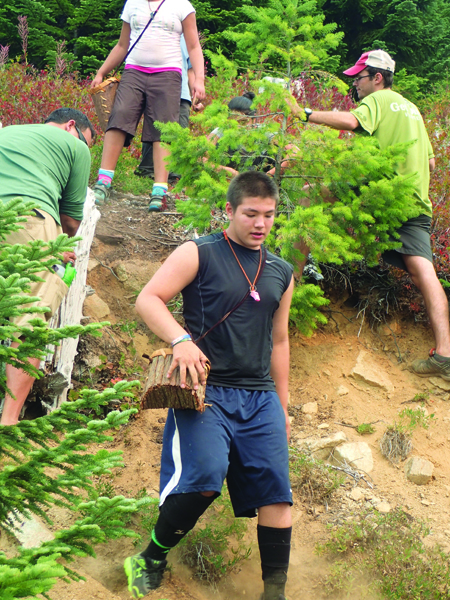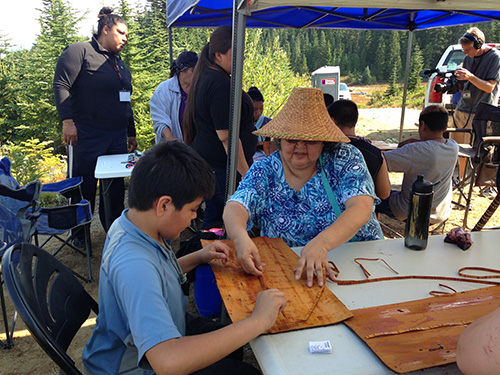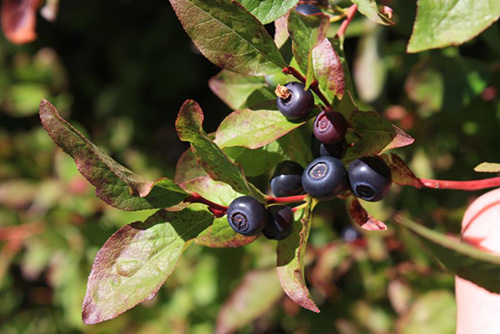
By Kalvin Valdillez, Tulalip News; Photos Courtesy of Libby Nelson, Tulalip Tribes Natural Resources
Annually, the Tulalip Tribes and the U.S. Forest Service hold a meeting regarding the Memorandum of Agreement (MOA) the two parties signed in 2007. The aforementioned MOA was created so that the Tulalip Tribes and the U.S. Forest Service can collaborate on the decision-making, planning, and counseling for the conservation of Tulalip’s resources on off-reservation ancestral lands in the Mt. Baker-Snoqualmie National Forest. This year the meeting was held on May 12, 2016.

During 2016’s MOA meeting Chairman Sheldon and Forest Supervisor Jamie Kingsbury signed an historic and important agreement, the “swədaʔx̌ali Co-Stewardship Plan, 2016-2026”. The agreement, a provision to the MOA, is a culture resource management plan that covers the swədaʔx̌ali area over the next ten years. swədaʔx̌ali or “Place of Mountain Huckleberries” is a 1,280-acre parcel in Tulalip ancestral lands in the upper Skokomish watershed that the Tulalip-Forest Service Co-Stewardship looks to enhance. One of the many reasons this is important to the tribe is the huckleberry.
Northwest huckleberries are generally picked in the late summer/early fall seasons, and grow in the damp areas of mountains. The huckleberry, known for boosting the immune system, has always had a strong relationship to the indigenous peoples of the northwest. Coastal Native American ancestors considered the huckleberry to be of the utmost importance because of the medicine the plant contains.
Inez Bill, Tulalip Tribes Rediscovery Program Coordinator, provided a foreword for the swədaʔx̌ali Co-Stewardship Plan. In the foreword Inez spoke of the significance huckleberries and the spiritual connection Natives have with the berry.
Inez writes, “Huckleberry is a food and medicine to our people. Our ancestors visited certain areas for gathering these berries. They knew where the berries were growing, and what companion plants were growing there too and how to utilize them.” Like fishing and hunting the huckleberry is essential to the Native American culture. Preserving these plants requires a lot of love and care. Inez stated that caring for the swədaʔx̌ali area offers a chance to pass on the knowledge of the huckleberry and it’s harvest to Tulalip’s future generations.
“Through the teachings of how we value, take care of and utilize our environment, we pass down our history and traditions, and what is important to the cultural lifeway’s of our people, said Inez. ‘This connection to the land enables us to know who we are as a people. It is a remembrance.”

Tulalip Tribes Natural Resources Environmental Policy Analyst, Libby Nelson, agrees that passing the knowledge to the youth is essential to preserving Tulalip’s natural resources. The co-stewardship between the Tribe and the Forest Service is a way to ensure that Tulalip cultural traditions live on.
Libby states, “Treaty rights encompass more than an opportunity to pick berries, hunt game or harvest fish. Having a meaningful role on the ground, in the stewardship of these resources, helps reconnect tribal peoples to these lands and the teachings of their ancestors”.
Last year the Tulalip Tribes hosted it’s first Tulalip Mountain Camp at swədaʔx̌ali for the youth of the Tulalip community, and looks to make it an annual trip. Inez detailed the trip stating that the youth were able to experience a connection to the mountains and ancestral lands, which in turn allowed the youth to bond with their families and community members by sharing what they learned and observed during their experience.
Tulalip’s Natural Resource Department and the Tulalip Youth workers will manage the swədaʔx̌ali area incorporating both traditional practices passed down from the ancestors and western science while nurturing the plants.
Libby stated that the forestry department is set to begin work on the swədaʔx̌ali area this summer. “As part of this plan, Forestry will be working on one of the major huckleberry areas this summer because it is threatened with getting shaded-out by conifers, which are small now and easier to move as opposed to two to three years from now when they start to vault out and will be more difficult to get out.”
The Natural Resource Department is looking to engage both summer youth workers and Tulalip Mountain Camp attendees to help remove the small conifers that are now about two-feet tall and have has many as 22,000 per acre.
According to a Seattle Times article from 1946, families camped, sometimes for the whole picking season, while gathering huckleberries. Gathering huckleberries was considered a fun social event where families from different tribes would travel to take part in the festivities including games, dances, and singing. Ceremonies were also held thanking the creator for the vitamin packed berry and asking for a blessed harvest.
Often referred to as a superfood, huckleberry offers an abundance of benefits to its consumer. For example, these berries contain large amounts of antioxidants, which help aid in the prevention of many diseases such as cancer, diabetes and heart diseases. In today’s society diabetes is a prevalent disease in communities all across Native America. The huckleberry is a reliable food that diabetics can enjoy without elevated blood sugar levels. Huckleberries are used in a variety of recipes including tea, pie, and jam. When used for medicinal purposes the huckleberry can be applied to treat pain, heart conditions, and infections.
The swədaʔx̌ali Co-Stewardship Plan is an imperative provision to the MOA between the Tulalip Tribes and U.S. Forest Service, as evidenced by Inez in her conclusion. “Today, it is not only important that we continue the struggle to uphold our treaty rights, but we need to be involved in taking care of those resources our culture depends on so that they will be available for our future generations. This work at swədaʔx̌ali is an expression of Tulalip’s sovereignty regarding our foods, and our commitment to support the dietary needs and the life ways of our people.”


